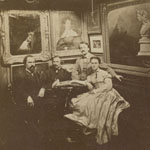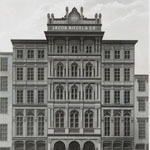The Sartains: A Family of Artists
Beginning in 1830, with the arrival from England of mezzotint engraver John Sartain (1808-1897), Sartain family members made their mark on Philadelphia’s artistic landscape. John Sartain became widely acknowledged as one of America’s best printmakers, receiving prestigious commissions for engraving large prints and illustrations for magazines and books. His artistic children and grandchildren included printmakers Samuel, Emily, and William; printer Henry; painters William, Emily, and Harriet; and art educators Emily and Harriet, who both served as administrators at Philadelphia School of Design for Women (now Moore College of Art and Design).Click on images for a larger view.
[Library of the Sartain Residence, 728 Sansom Street]] (Philadelphia, ca. 1865). Albumen print stereograph.
John Sartain filled his home (which also served as his workshop) with paintings, engravings, art objects, and books to produce the aura of a successful artist to friends and potential clients. Landscapes, portraits, and genre scenes adorn the walls of the library where Sartain sits with three of his children. From left to right the sitters are: Samuel (1830-1906), John (1808-1897), William (1843-1924), and Emily (1841-1927). |
|
Samuel Sartain. Jacob Riegel & Co., Importers & Jobbers of Dry Goods (Philadelphia, ca. 1870). Engraving. Acquired from the Jay T. Snider Collection.
Jacob Riegel moved his dry goods business to this Market Street location in the late 1860s. Perhaps to celebrate this move, the company commissioned leading Philadelphia photographer Frederick Gutekunst (1833-1917) to document its impressive building. Gutekunst’s photograph served as the basis for this engraving by Samuel Sartain (1830-1906). The company carried both foreign and domestic dry goods, noting in an advertisement that it always had in stock a wide selection of goods made in Philadelphia. After the death of Jacob Riegel in 1880, the firm went into a decline and was bought out by John Wanamaker in 1886.
|

